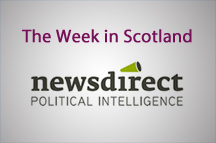 The publication of the Scottish Government’s discussion paper on income tax poses a number of challenges. To the other Holyrood parties, there is the invitation to take part in a “grown-up” debate about the use of this newly-devolved mechanism. To the Scottish taxpayer, there’s a suggestion that to get the necessary investment in schooling, policing and health services, then those who can afford to pay more, should. And to the First Minister and her inner-circle, there’s the big decision of how to evaluate the responses, determine a way forward to raise the necessary revenue and get a Budget passed.
The publication of the Scottish Government’s discussion paper on income tax poses a number of challenges. To the other Holyrood parties, there is the invitation to take part in a “grown-up” debate about the use of this newly-devolved mechanism. To the Scottish taxpayer, there’s a suggestion that to get the necessary investment in schooling, policing and health services, then those who can afford to pay more, should. And to the First Minister and her inner-circle, there’s the big decision of how to evaluate the responses, determine a way forward to raise the necessary revenue and get a Budget passed.
The four tests as set out in the document
Four tests have been set out as principles to guide the final approach:
- Maintain and promote the level of public services which the people of Scotland expect;
- Ensure the lowest earning taxpayers don’t see their taxes increase;
- Make the tax system more progressive and reduce inequality; and
- Along with corresponding decisions on spending, support the economy.
As the early discussions have already illustrated, these are not without conflict, so in the absence of any weighting, there may be some fuzzy logic involved in the final plan. Not least, from what we know of this particular administration, we shouldn’t underestimate their ability to harness arguments (and hold the line very consistently) in support of the particular world view that fits the policy purpose – and crucially, the private polling.
 So, what’s being proposed?
So, what’s being proposed?
The document summarises the Holyrood party positions, but given the unassailable logic that a majority vote requires someone, somewhere to compromise, the real interest lies in the Alternative Approaches section. Here, options for bandings are expanded from three to six with accompanying analysis (including the number of taxpayers in each proposed income bracket). With each splitting of a band, the impact on some taxpayers is softened but predictions about behaviour change to minimise tax exposure means that there are always some quirks in the revenue estimates. Only the six-band option includes a lower initial rate of 19p for those on the lowest earnings (£11,850 - £15,000), benefitting 386,000 people. The optics of this look interesting but questions have already been raised as to whether it complicates aspects of welfare benefits.
What is likely to happen?
At the launch event yesterday, the First Minister gave more than a clue to her direction of travel: “I think the time is right to consider modest additional contributions to protect the thing we hold dear”. With current parliamentary arithmetic, the SNP group either need the backing or abstention of another party. For the Scottish Conservatives, other than the small matter of independence, this is the issue where they feel they have most traction with the voters. Repeated polling also suggests that there’s no public support for paying more tax, but as ever the framing of the question can be crucial, as politicians well know.
In the current climate and with a significant chunk of the discussion paper devoted to options not previously mooted by any party, it looks likely that additional bands will deliver the more progressive option required to satisfy the third test. With air passenger duty off the table for this year’s Budget, then the Scottish Greens remain the party most likely to find an acceptable compromise along this route if they are willing to relax their position on rates for higher earners. At FMQs yesterday, Patrick Harvie was keen to promote reform of local taxation models and in terms of the longer game, this may be where commitments can be sought for both the immediate term and further ahead.
What happens next?
Though it’s understandable why the Scottish Budget must wait for the UK Government to confirm details of our block grant, we Scots will be 14 days into our advent calendar chocolates before the draft plan is actually unveiled.
Looking beyond April, there is also the small matter of how quickly the voting public feel the impact of any increased public investment. Labour were keen this week to suggest that £700-800m is the actual investment required. The highest revenue estimate in the options presented is £290m. Five year terms might feel a long time in politics, but it’s worth noting that this first attempt to set a specific income tax approach for Scotland runs to March 2019, at which point the parties have just 18 short months to get on an election footing.
And no, I’ve not even mentioned the B-word…













